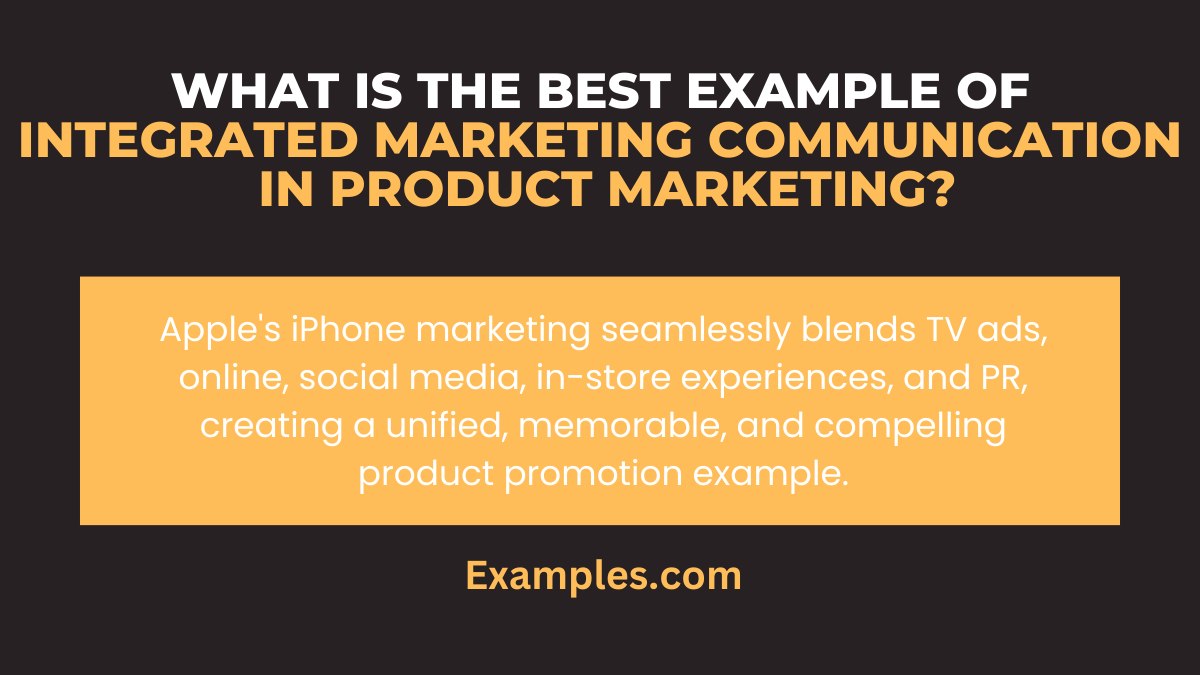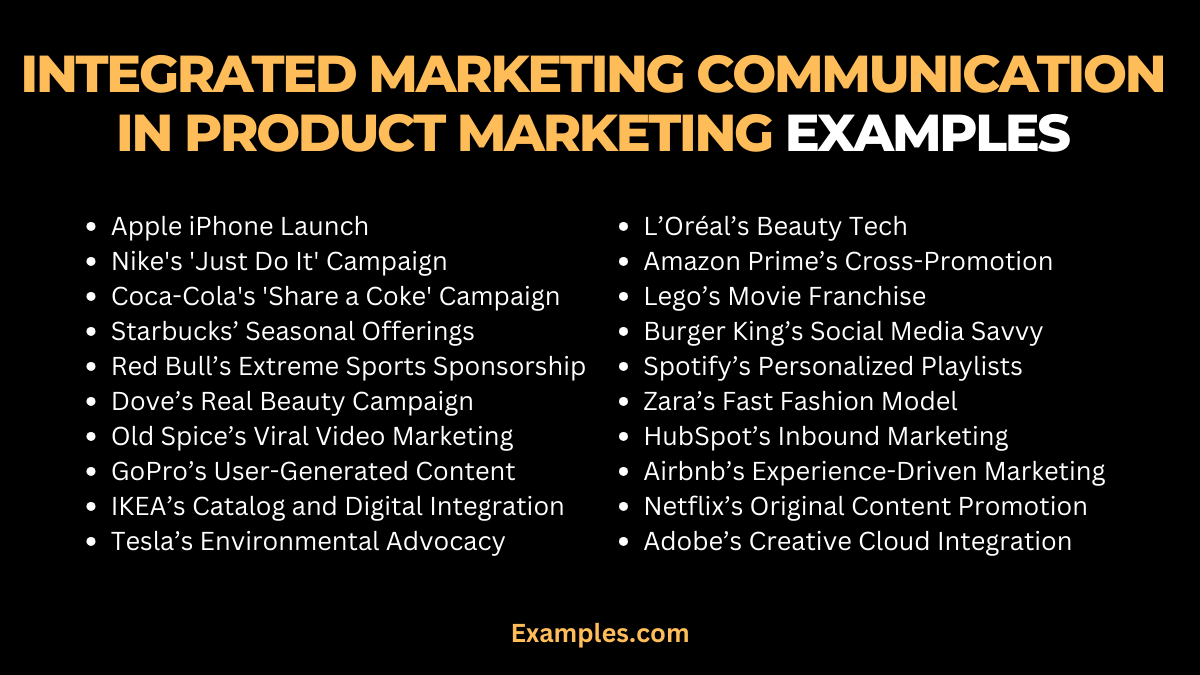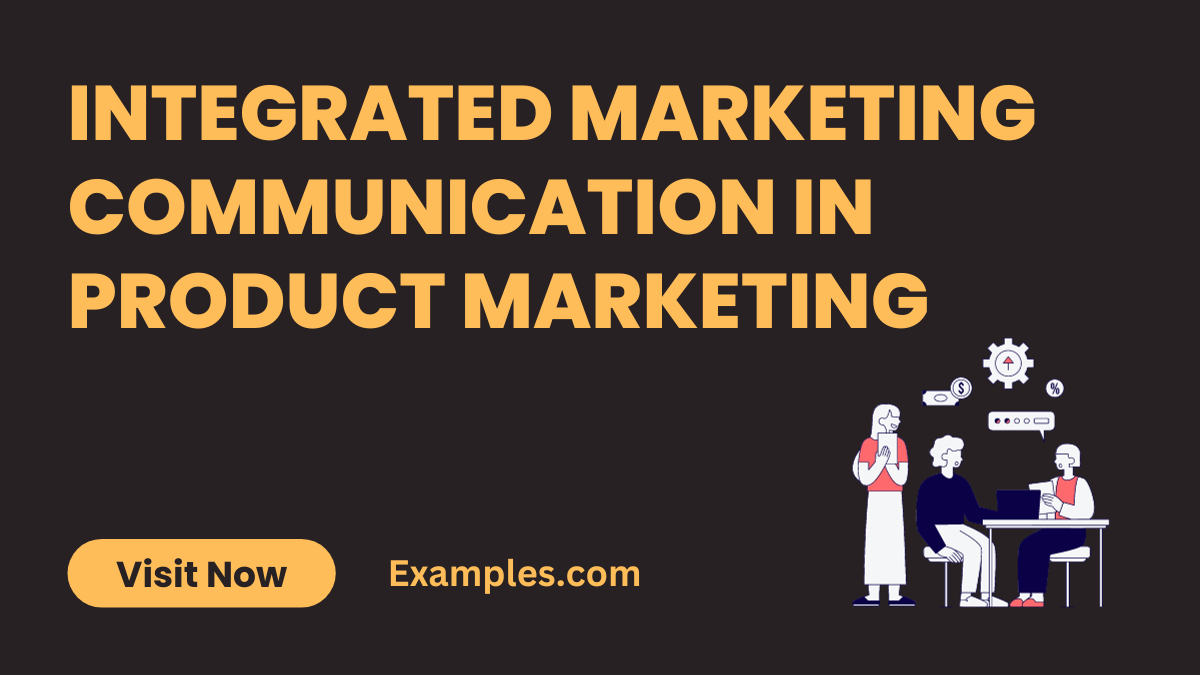19+ Integrated Marketing Communication in Product Marketing Examples
Integrated Marketing Communication (IMC) in product marketing is a synergistic approach combining various marketing methods to create a cohesive, customer-centric promotional strategy. This guide delves into the essence of IMC, highlighting key Communication Examples and illustrating how they seamlessly integrate to amplify product messaging. We’ll explore real-world examples demonstrating the effectiveness of this unified marketing strategy, offering insights into how IMC elevates brand presence and consumer engagement.
What is Integrated Marketing Communication in Product Marketing? – Meaning

Integrated Marketing Communication in product marketing is a strategic approach that blends different promotional tools and channels to convey a consistent message about a product or service. It aims to ensure that all forms of communication, such as advertising, public relations, and digital marketing, are carefully linked together. This cohesion enhances the overall impact of the marketing efforts, creating a unified voice that resonates more effectively with the target audience.
What is the Best Example of Integrated Marketing Communication in Product Marketing?

The best example of Integrated Marketing Communication in product marketing is often seen in comprehensive campaigns by major brands. A standout example is Apple’s marketing for its iPhone line. Apple expertly combines television and online advertising, social media campaigns, in-store experiences, and public relations events. Each element works in harmony, consistently reinforcing the product’s innovative features and sleek design. This unified approach not only strengthens the brand image but also creates a more compelling and memorable experience for consumers.
20 Integrated Marketing Communication in Product Marketing Examples

Integrated Marketing Communication (IMC) in product marketing plays a crucial role in unifying a brand’s message across various platforms. This approach enhances brand engagement and ensures a consistent customer experience. Below are 20 distinct and impactful examples of IMC, each illustrating successful strategies and their remedies:
- Apple iPhone Launch: Unified advertising, events, and online presence.
- Nike’s ‘Just Do It’ Campaign: Inspirational ads with celebrity endorsements.
- Coca-Cola’s ‘Share a Coke’ Campaign: Personalized marketing and social media integration.
- Starbucks’ Seasonal Offerings: Coordinated in-store and digital promotions.
- Red Bull’s Extreme Sports Sponsorship: Product promotion meets event marketing.
- Dove’s Real Beauty Campaign: Consistent messaging across media platforms.
- Old Spice’s Viral Video Marketing: Shareable, humorous content on social media.
- GoPro’s User-Generated Content: Customer videos in marketing.
- IKEA’s Catalog and Digital Integration: Traditional catalogs with augmented reality.
- Tesla’s Environmental Advocacy: Product marketing with a sustainability message.
- L’Oréal’s Beauty Tech: Digital marketing meets tech-driven products.
- Amazon Prime’s Cross-Promotion: Bundling services under one membership.
- Lego’s Movie Franchise: Brand storytelling through entertainment.
- Burger King’s Social Media Savvy: Interactive, trend-based campaigns.
- Spotify’s Personalized Playlists: Data-driven music customization.
- Zara’s Fast Fashion Model: Trend-responsive products and marketing.
- HubSpot’s Inbound Marketing: Valuable content attracting customers.
- Airbnb’s Experience-Driven Marketing: Linking products with local experiences.
- Netflix’s Original Content Promotion: Driving subscriptions through exclusive series.
- Adobe’s Creative Cloud Integration: Cross-promotion within a product suite.
Integrated Marketing Communication in Product Marketing Strategy
Integrated Marketing Communication Strategies in product marketing encompass various channels and techniques to create a cohesive brand message. These strategies, key Components of Integrated Marketing Communications Examples, align marketing efforts across different mediums. Here are five distinct examples:
- Google’s AI-Driven Ads: Utilizes AI for personalized advertising. “Use AI to create relevant, targeted ads.”
- Unilever’s Sustainable Branding: Focuses on eco-friendly messaging across platforms. “Consistently promote sustainability in all communications.”
- Adidas’ Influencer Collaborations: Leverages influencers for broader reach. “Collaborate with influencers to echo brand ethos.”
- BMW’s Luxury Branding: Maintains premium messaging across channels. “Uphold luxury in every communication.”
- Pepsi’s Interactive Campaigns: Engages customers through digital interactivity. “Create engaging, interactive online content.”
Integrated Marketing Communication in Product Marketing Tools
IMC tools in product marketing are integral to executing strategies, reflecting What does Integrated Marketing Communications Include?. These tools ensure consistent messaging across various platforms. These strategies and tools are vital Components of Integrated Marketing Communications, serving various Functions of Integrated Marketing Communications. Mastery in these areas can lead to diverse career paths, as highlighted in IMC Jobs, Careers, Salaries. Furthermore, for those seeking academic advancement, Integrated Marketing Communication Degrees provide specialized knowledge in these areas. Here are five key tools:
- Salesforce CRM: Manages customer data for targeted marketing. “Employ CRM for personalized customer engagement.”
- Hootsuite for Social Media: Orchestrates social media efforts. “Utilize Hootsuite for cohesive social media strategy.”
- Mailchimp for Email Marketing: Automates and customizes email campaigns. “Use Mailchimp for tailored email communication.”
- Google Analytics: Offers insights for digital marketing. “Analyze web traffic for informed marketing decisions.”
- Adobe Creative Suite: Creates consistent visual content. “Develop brand-aligned visuals with Adobe tools.”
Download Integrated Marketing Communication in Product Marketing Tools PDF
Integrated Marketing Communication in Product Marketing Promotion Mix
The promotion mix in IMC for product marketing combines various promotional tools to effectively engage audiences, highlighting What is the Purpose of Integrated Marketing Communications. Here are five examples:
- Amazon’s Omnichannel Retailing: Integrates online and offline retail experiences. “Promote seamless shopping across channels.”
- Disney’s Cross-Platform Storytelling: Ensures story consistency across media. “Narrate a cohesive brand story on all platforms.”
- McDonald’s Localized Marketing: Adapts promotions to local cultures. “Tailor marketing to reflect local nuances.”
- Sony’s Product Placement: Strategically places products in media. “Integrate products subtly in popular content.”
- Visa’s Global Sports Sponsorships: Utilizes global events for brand exposure. “Leverage global events for brand visibility.”
What is Integrated Marketing Communication in the Product Marketing Life Cycle?
Integrated Marketing Communication (IMC) plays a critical role throughout the product marketing life cycle. It ensures that every marketing effort, from the product launch to its maturity, is cohesive and aligned with the overall brand strategy. This approach is essential for achieving Integrated Marketing Communication Objectives and understanding the Importance of Integrated Marketing Communications.
- Introduction Stage: At this stage, IMC focuses on building awareness and interest in the new product. Techniques like targeted advertising and influencer partnerships are crucial.
- Growth Stage: Here, the emphasis shifts to differentiating the product and expanding market share. Effective IMC strategies might include diversified advertising and enhanced public relations efforts.
- Maturity Stage: During maturity, maintaining brand loyalty becomes key. Techniques like customer engagement campaigns and loyalty programs are employed.
- Decline Stage: In this phase, IMC helps in either rebranding or finding new markets for the product. Strategies may involve repositioning the product or exploring new marketing channels.
- Post-Life Cycle: Even after a product is phased out, IMC is important for maintaining a positive brand image and setting the stage for future product introductions.
What are the Stages of Integrated Marketing Communication in Product Marketing?
The stages of Integrated Marketing Communication in product marketing involve a series of steps designed to create and maintain a strong, cohesive brand presence. Incorporating Integrated Marketing Communication in Tourism, for instance, would require tailoring these stages to effectively reach and engage travelers, highlighting unique experiences and destinations through a blend of traditional and digital marketing channels. The careful application of these stages ensures the success of IMC efforts across various industries. These stages are foundational in developing and employing Integrated Marketing Communication Techniques.
- Strategic Planning: This initial stage involves setting IMC objectives and defining the target audience. It’s where the groundwork for the communication strategy is laid.
- Message Creation: Here, the focus is on crafting a compelling message that resonates with the audience, aligning with the brand’s overall voice and objectives.
- Channel Selection: This involves choosing the right mix of channels—digital, print, social media, etc.—to effectively disseminate the message.
- Implementation: At this stage, the IMC plan is put into action. This involves executing marketing campaigns and monitoring their progress.
- Evaluation and Adjustment: The final stage entails measuring the effectiveness of the IMC efforts and making necessary adjustments for improvement.
Integrated Marketing Communication (IMC) in Product Marketing Objective
to create a unified and cohesive message across all marketing channels. This objective is essential for enhancing the effectiveness of marketing campaigns and strengthening brand loyalty. By integrating various channels like advertising, sales promotions, social media, and public relations, IMC builds brand awareness and ensures a consistent message, which is crucial for retaining customer trust and achieving marketing communication objectives.
To develop an effective IMC strategy, the first step is identifying your target audience, considering factors such as demographics and psychographics. The next step involves setting clear objectives, which should be SMART (Specific, Measurable, Achievable, Relevant, Time-bound).
This strategic approach in IMC is particularly effective in product marketing, as it aligns all marketing efforts towards a common goal, maximizes the impact of the message, and optimizes resource utilization.
For more detailed information on developing an integrated marketing communications strategy, you can refer to these resources:
- Ahrefs for insights on the right mix of marketing channels and campaign effectiveness.
- HubSpot for a guide on building an integrated marketing campaign.
- Courses by Lumen Learning for understanding objectives and approaches in IMC.
- University of Southern California for an overview on developing an IMC plan and the future of marketing communications.
What is Integrated Communication in Marketing?
Integrated communication in marketing is a strategy combining various Marketing Communication Channels to ensure a cohesive and effective message, aligning with Marketing Communication Objectives.
What is an Integrated Marketing Communications Plan for a Product?
An Integrated Marketing Communications Plan for a product outlines a strategy to promote it across multiple channels, incorporating elements like Integrated Marketing Communication in Public Relations and Service Marketing.
What are the Components of Integrated Marketing Communication?
The four components of Integrated Marketing Communication are:
1) Advertising
2) Public Relations
3) Sales Promotions
4) Direct Marketing, each contributing to the overall Marketing Communication Process.
In conclusion, Integrated Marketing Communication in Product Marketing is a vital strategy that harmonizes various promotional efforts for maximum impact. Through diverse examples, we’ve seen its powerful effects on brand awareness and customer engagement. Embracing this approach ensures that every marketing channel works in unison, leading to more effective and resonant campaigns.



